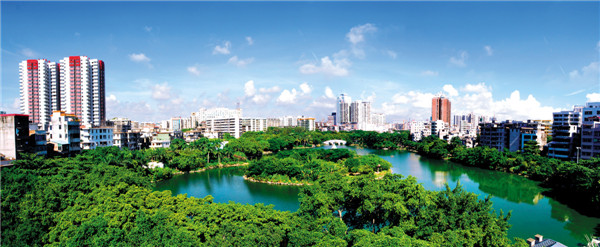Zhanjiang
 0 Comment(s)
0 Comment(s) Print
Print E-mail China.org.cn, February 6, 2015
E-mail China.org.cn, February 6, 2015
|
|
|
Zhanjiang city, Guangdong province [Photo by Chen Mingli/ Zhanjiang.gov.cn] |
Zhanjiang sits in a transitional zone between the tropics and subtropics, and enjoys abundant optothermal resources and plentiful rainfall. Forest land covers an area of 302,500 hectares; forest coverage rate stands at 29.11 percent; and forest growing stock has reached 20.13 million cubic meters. Eucalyptus cultivation forest area has hit 220,000 hectares and is China’s largest. The mangrove forest area is 9,300 hectares, also the largest in China, accounting for 78 percent of all in Guangdong and 33 percent in China. A horsetail beefwood protection forest at coastal hurst covers an area of 16,700 hectares and runs more than 500 kilometers. It is called green the Great Wall in coastal areas and territorial seas and is the longest and most intact of the country’s coast protection forests.
Zhanjiang is a green leisure city; a major national production base for sugar cane, fruits and vegetables; as well as the biggest production area for eucalyptus seedlings and sisal hemp. The city is also famous for its pineapples, bananas, mangos and red oranges.
With a blue sea, beautiful beaches and coconut trees, Zhanjiang has rich tourism resources. The city has 12 State-level A-class scenic spots, including Huguang Scenic Area of Zhanjiang District of Leiqiong Global Geopark, the historical city of Leizhou, the Longhaitian Tourist Resort and Zhanjiang Bay Scenic Spot.
There are seven colleges and universities in Zhanjiang, second only to Guangzhou, capital city of Guangdong province. It also has 75 secondary vocational schools, 39,000 professionals and technical personnel, three key laboratories, six engineering research centers, 18 research institutes, and 47 technology development institutions affiliated to enterprises. Together, they have contributed a lot to Zhanjiang’s fast growth.







Go to Forum >>0 Comment(s)